

Candida under the microscope. Eliminating Candida with Flower Essences, Tree Essences and Gem Essencesby Mary Kurus What Is Candida Candida is the name given to an illness that reflects the spread and overgrowth of different types of candida yeast creating a variety of health difficulties.
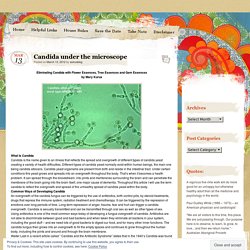
Different types of candida yeast normally exist within human beings, the main one being candida albicans. Candida yeast organisms are present from birth and reside in the intestinal tract. Under certain conditions this yeast grows and spreads into an overgrowth throughout the body. That’s when it becomes a health problem. Candidiasis (Mucocutaneous) - Dermatologic Disorders. Intertriginous infections manifest as pruritic, well-demarcated, erythematous patches of varying size and shape; erythema may be difficult to detect in darker-skinned patients.

Primary patches may have adjacent satellite papules and pustules. Perianal candidiasis produces white maceration and pruritus ani. Candidal nail infections can affect the nail plate, edges of the nail, or both. Candidal infection is a frequent cause of chronic paronychia, which manifests as painful red periungual swelling. Candidiasis (Invasive) - Infectious Diseases. Histopathology and fungal cultures Serum beta-glucan testing Because Candida species are commensal, their culture from sputum, the mouth, the vagina, urine, stool, or skin does not necessarily signify an invasive, progressive infection.
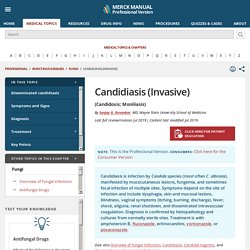
A characteristic clinical lesion must also be present, histopathologic evidence of tissue invasion (eg, yeasts, pseudohyphae, or hyphae in tissue specimens) must be documented, and other etiologies must be excluded. The hidden signs and symptoms of a Yeast Overgrowth? What you need to know... 048: Troubleshoot Your Intestinal Bacteria, Candida + SIBO. Understanding how the body works-Part 2 with Dr Jerry Tennant. Candida Albicans (Fungus) Issues. Is Cancer a Fungus? A New Theory. This video and chapter offers crucial information about the relationships between cancer and infectious threats that every cancer patient and their family must be aware of.
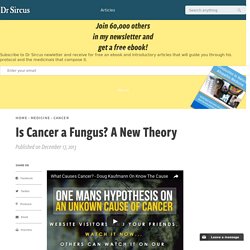
The truth that we must stare down is that cancer and infections cannot be separated from each other. Cancer—always believed to be caused by genetic cell mutations—can in reality be caused by infections from viruses, bacteria, and fungi. “I believe that, conservatively, 15 to 20% of all cancer is caused by infections; however, the number could be larger—maybe double,” said Dr. Andrew Dannenberg, director of the Cancer Center at New York-Presbyterian Hospital/Weill Cornell Medical Center. Dr. Whether caused by infections or not, once cancerous conditions are well underway the weakening of the immune system and the battle that ensues between the good guys and the bad is cheered on by hordes of infectious agents that increase in density, power and form as a patient’s cancers get worse.
Dr. Dr. According to Dr. Dr. A.V. Fungi as Human Pathogens. Fungi as Human Pathogens Introduction Fungi that are pathogens are usually plant pathogenic Fungi.
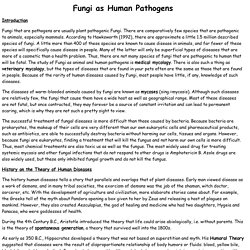
There are comparatively few species that are pathogenic to animals, especially mammals. Fungi: Death Becomes Them - CrashCourse Biology #39. All You Need To Know About Cryptosporidium - YeastInfection.Org by Eric Bakker N.D. Cryptosporidium is a parasite which was first identified in 1907 by a scientist called Tyzzer and which can cause an illness called Cryptosporiodiosis.

The main offenders when it comes to strains are Cryptosporidium hominis and Cryptosporidium parvum although other strains can sometimes be contracted by humans. Unfortunately this illness most commonly affects children particularly those in the age range of 1-5, and although it is self-limiting it can cause digestive issues including mild or severe watery diarrhea which is distressing to those in this age group. Others who are particularly susceptible to infestation and become symptomatic are those people, including adults, who have an impaired immune response.Signs and Symptoms of Cryptosporidium The most widely recognized symptom of a cryptosporidium infestation is watery diarrhea. This can be mild but more often it is quite severe if relatively short-lived. Related articles: How to Cure Candida in 6 Steps. Annualreviews.
Filamentation in Candida auris , an emerging fungal pathogen of humans: passage through the mammalian body induces a heritable phenotypic switch. Candida Cleanse: How To Do A Proper Candida Cleanse & Get Rid of Candida Overgrowth (Updated 2018) Types of Fungal Diseases. Candida Diet Plan. Michael King – Improper Food Combining Causes Candida & Yeast Infections. The life of Yeast. 10 Keys to Conquer Candida. The hidden signs and symptoms of a Yeast Overgrowth? What you need to know... Caprylic Acid Fights Candida, Infections & Acne. Caprylic acid is a type of beneficial saturated fatty acid that has antibacterial, antiviral, antifungal and anti-inflammatory properties.
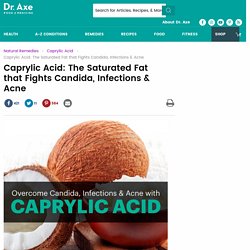
Found in healing foods like coconut and coconut oil, cow’s milk, and human breast milk, it’s been linked to prevention of urinary tract infections, bladder infections, Candida virus, sexually transmitted diseases, oral infections like gingivitis and many other conditions. As one of the three primary fatty acids (along with capric acid and lauric acid) found in coconut oil, caprylic acid has recently become widely known for its antifungal effects, especially in regard to keeping the digestive and reproductive organs — including the bladder, gut and urethra — functioning properly.
One of the most popular uses for caprylic oil, whether consumed as part of foods or taken orally in tablet form, is preventing the overgrowth of yeast-like fungus that can live and grow in your intestines. Click here for a free download on the 6 benefits of caprylic acid! 1. 2. Enema Solution For Candida: How Enema Can Help Get Rid Of Your Candida. What is the Best Natural Treatment for a Candida Infection? What Is Candida Yeast Infection* Candida is a form of yeast, or fungus, that’s naturally found on and in our bodies.
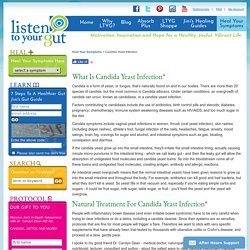
There are more than 20 species of candida, but the most common is Candida albicans. Under certain conditions, an overgrowth of candida can occur, known as candidiasis, or a candida yeast infection. Factors contributing to candidiasis include the use of antibiotics, birth control pills and steroids; diabetes; pregnancy; chemotherapy; immune system weakening diseases such as HIV/AIDS, and too much sugar in the diet. Candida symptoms include vaginal yeast infections in women, thrush (oral yeast infection), skin rashes (including diaper rashes), athlete’s foot, fungal infection of the nails, headaches, fatigue, anxiety, mood swings, brain fog, cravings for sugar and alcohol, and intestinal symptoms such as gas, bloating, constipation and diarrhea. Proteomic analysis of protein phosphatase Z1 from Candida albicans. Abstract Protein phosphatase Z is a “novel type” fungus specific serine/threonine protein phosphatase.

Previously our research group identified the CaPPZ1 gene in the opportunistic pathogen Candida albicans and reported that the gene deletion had several important physiological consequences. In order to reveal the protein targets and the associated mechanisms behind the functions of the phosphatase a proteomic method was adopted for the comparison of the cappz1 deletion mutant and the genetically matching QMY23 control strain. ReSet the Yeast Connection – Carolyn Dean MD ND – RnA ReSet Blog and Radio Show Archive. Books Download your FREE e-book with my proven system that has helped many overcome the effects of candida yeast overgrowth.
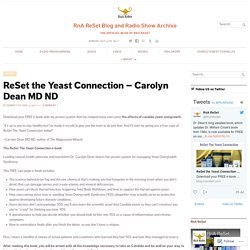
“It’s up to you to stay healthy but I’ve made it my job to give you the tools to do just that. And I’ll start by giving you a free copy of ReSet The Yeast Connection today!” –Carolyn Dean MD ND, author of The Magnesium Miracle The ReSet The Yeast Connection e-book. Candida Diet Guidelines. Basic Candida Diet Guidelines will enable you to create your own healthy meals at home and still get rid of a candida yeast infection naturally and avoid recurring flare ups.
The main principle to keep in mind with an anti-candida diet is that you are trying to starve the yeast fungus. This means eating no foods which feed yeast directly, or encourage yeast by being yeasty, mouldy or fermented in their own right. Iridology Lesson #2 Sulfur & Candida: How to Spot & Detox It Out. Ep #463 – Erin Porter - How To Heal From Fungal Infections Naturally & Her Story of Recovery - Extreme Health Radio. Plasticity of Candida albicans Biofilms. New light shed on mysterious fungus that has major health consequences. Researchers at the University of Toronto examined fungi in the mucus of patients with cystic fibrosis and discovered how one particularly cunning fungal species has evolved to defend itself against neighbouring bacteria. A regular resident of our microbiome -- and especially ubiquitous in the lungs of cystic fibrosis patients -the Candida albicans fungus is an "opportunistic pathogen.
" This means it usually leaves us alone, but can turn against us if our immune system becomes compromised. In fact, this fungus is among the most common causes of bloodstream infections, such as sepsis. As the population living with weakened immune systems has risen substantially over the past two decades -- people living with HIV, having organ transplants or undergoing cancer chemotherapy are some examples -- opportunistic fungal pathogens like this one have become an even greater threat. Progress in the fight against harmful fungi. A group of researchers at the Max F.
Perutz Laboratories has created one of the three world's largest gene libraries for the Candida glabrata yeast, which is harmful to humans. Molecular analysis of the Candida glabrata fungus mutations led to the discovery of 28 new genes that are partly responsible for the yeast's tolerance of common drugs. Infectious diseases caused by fungi, viruses, bacteria and parasites represent the world's number one cause of death. A few dozen types of harmful fungi claim more than 1.5 million human lives every year.
MMDB Protein Structure Summary, 1Q42, 25716. Candida and Cancer connection - Daily Alternative News - Alternative News - Something Different for the People! Candida Albicans is a fungal yeast that is present naturally in the human gut; everyone has Candida albicans living within them to some extent. Our gut is also full of natural bacteria that feed on the yeast and so keep levels to a low number and stop it from becoming a problem. The yeast becomes problematic when it grows beyond normal levels and spreads throughout the gastrointestinal tract, into the bloodstream and from there throughout the body. The yeast then does something remarkable and changes into fungus. This fungus now settles itself into the tissue and a fungal colony quickly spreads.
The fungus is protected from the environment as it has now left the gut and does not have the challenge of the gut bacteria trying to consume it. Sadly more and more people suffer from low immune systems due to stress, bad diet or general ill health. Candida overgrowth - 12 things you absolutely need to avoid if you have it. Candida Online Health Class with Byron J. Richards. (These files require Flash 8 to play. Download for free here.) Weight Management & Detoxification – (from June 28, 2008 class)Fibromyalgia & Muscles – (from June 10, 2008 class) Leptin Diet Weight Management – (from May 17, 2008 class)Mastering Cardiovascular Health – (from February 23, 2008 class)
How mercury fillings cause Candida overgrowth. (NaturalNews) So you don't indulge in sugar. You never take antibiotics. You eat a pretty good diet. CANDIDA YEAST PARASITE: How Bad Is It? Candida produces toxic chemicals and disease. Tue. Apr. 1, 2014 by Jonathan Landsman. Cancer develops from fungal infections, like Candida. Naturally and Holistically Curing Allergies By Eliminating Candida. A typical allergy-prone individual has to take a pill every twelve hours endlessly if he trusts orthodox medicine to treat him, and this merely suppresses the symptoms temporarily.
Do I Have Problems with Candida? That Truth about Candida...what works, what doesn't. Naturally and Holistically Curing Allergies By Eliminating Candida - The Health Wyze Report. Fight Deadly Yeast Infections With This One Natural Thing. Photo credit: bigstock.com. Candida is not your enemy! But here's the easiest way to get rid of it ASAP anyway... Candida: A Serious Health Risk That Can Cause Systemic Toxicity.